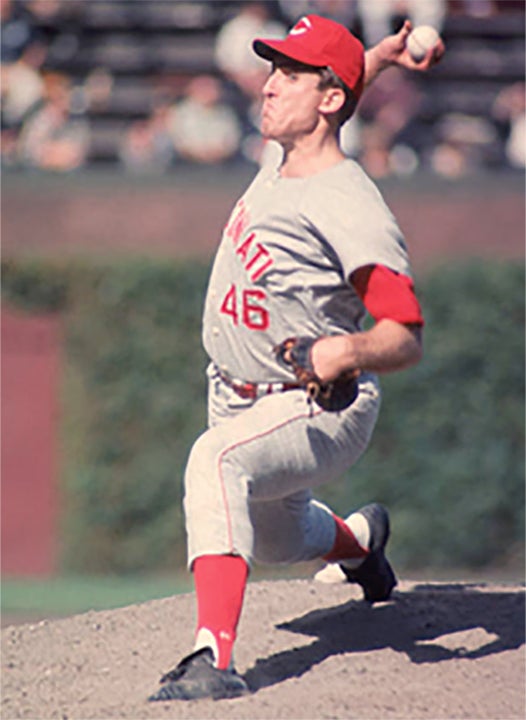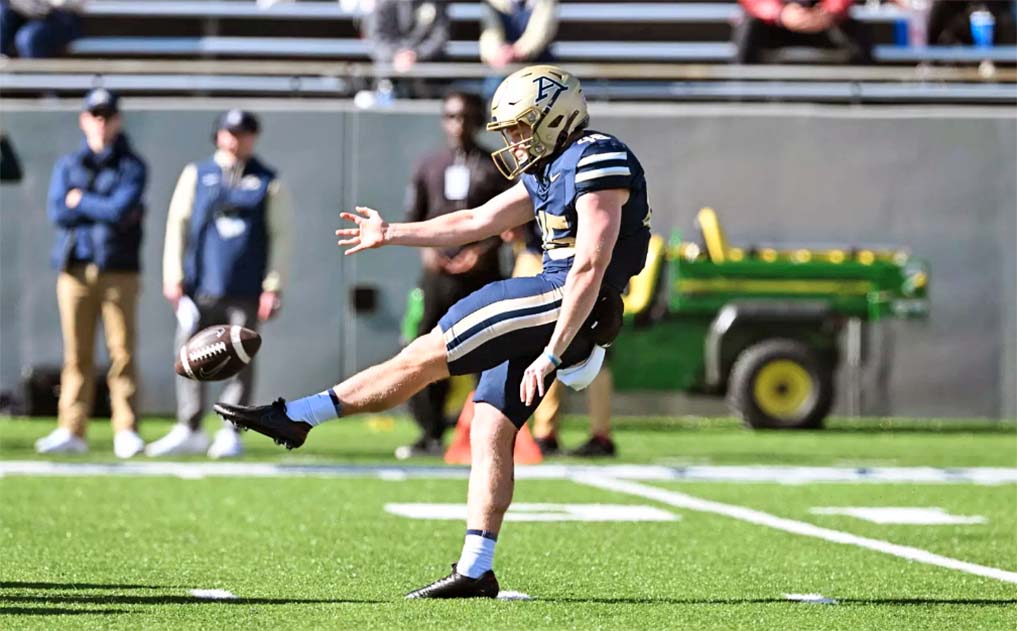No pitch count enabled Maloney to throw no-hitter against Cubs
Published 11:21 pm Sunday, August 20, 2023

Cincinnati Reds’ pitcher Jim Maloney throws a no-hitter at Chicago on August 19, 1965. (AP File Photo)
By Jim Walker
jim.walker@irontontribune.com
After the seventh inning in a game last week, Philadelphia Phillies manager Rob Thomson told pitcher Michael Lorenzen he better start making quick work of the Washington Nationals batters. He told Lorenzen he only had about 20 pitches left.
Lorenzen went to work and finished with the no-hitter and a career-high 124 pitches thrown in a game.
That’s all? 124???
On August 19, 1965, Cincinnati Reds pitcher Jim Maloney threw a no-hitter in Chicago as he beat the Cubs 1-0 in 10 innings.
Shortstop Leo Cardenas hit a home run on the first pitch from Cubs’ Larry Jackson with one out in the top of the 10th inning. The ball hit into the foul pole screen that was in fair territory.
Maloney then went out and retired the side but not until he walked leadoff hitter Doug Clemeens.
The walk was the 10th of the game Maloney issued who struck out 12 batters on the day and also hit one man.
Maloney threw 187 pitches that included 14 full count pitches.
“I felt good all the way. I really did,” Maloney said when asked about his pitch count.
Maloney— a good hitting pitcher who Baltimore considered drafting him as a shortstop or second baseman — also had a pair of singles in the game as he went 2-for-4 which meant his was on base instead of resting in the dugout.
Although his control was eratic, Maloney was still throwing hard.
“They had no pitch counts. If you were throwing the ball good and getting guys out, the way the manager could tell and the way you could tell was they started getting good swings on me and started getting better contact on the ball and I wasn’t fooling anybody or I couldn’t get the ball by somebody. The hitters would let the manager know (the pitcher) was losing a little bit of his stuff,” said Maloney.
“When I got to the ninth inning I was sitting on the bench and I looked at the scoreboard and I’m thinking to myself two months have gone by and I’m in the same position. It’s hard to stay positive. I’ve got to go out there and not give up a run or I get beat because we’re playing in Chicago and we have no chance to come back.
“I was on deck and (shortstop) Leo (Cardenas) hit a ball that I could see was curving. He had enough to get it out I thought. He hooked it and it hit the flag pole maybe 10 feet above the wall for a home run.
It was the second time that season Maloney had gone 10 innings with a no-hitter. He lost 2-0 at home in 11 innings to the New York Mets when Johny Lewis led off the 11th with a home run. The Mets also got a single later in the inning.
Maloney was credited with a 10-inning no-hitter but a rule change in 1971 by Major League Baseball erased the no-hitter.
Maloney struck out 18 batters to set a record for most strikeouts in an extra inning game.
“That night was probably as good of stuff as I ever had. Billy Cowan was the leadoff hitter for the Mets and later on we were teammates with (California) when I got traded to the Angels and Cowan was already there,” said Maloney. “(Cowan) told me when he faced me that night that I threw him two fastballs and a curve and ‘I never got the bat off my shoulder and went back to the dugout and I told my teammates you can forget it tonight boys.’ That’s what he told me.”
Maloney finished his career with two no-hitters and five one-hitters. Throwing the ball between 99 and 102 miles an hour back when pitches were clocked coming across home plate and not their exit velocity like in today’s game.
There was even a report he was once clocked at 110 miles an hour. He just shrugged it off.
“I don’t know anything about that. That might be some fake news,” Maloney said with a laugh. “I would challenge hitters. If they knew a fastball was coming, you better put it in a good spot. I knew I had the speed but I don’t know how hard I threw. I’d say it had to be around 100 and I was like that for nine innings.”
Maloney approached every game with the idea of pitching a no-hitter.
“That’s how I stayed in the game. I always said I was going to pitch a perfect game. So, I’d start and get the first guy out and I’d say I’ve got 26 more. I’d get the next guy and say I have 25 more. If a guy got a hit off me, I’d say I’m going to throw a one-hit shutout,” said Maloney.
“I felt that I had a chance to pitch a no-hitter every time I went out there or a perfect game.”
Maloney pitched his second no-hitter — or third depending on your opinion of the MLB rule — came when he beat the Houston Astros 10-0 on April 30, 1969.
“That game was nothing like the other games. I knew I had a no-hitter the whole way, but any time a team gets you a bunch of runs like that it’s much easier to go,” said Maloney
“But you have to keep in the frame of mind that it’s like a zero-zero game and just go through the motions like this is going to happen. You can get yourself in trouble. You have to stay in the game mentally and each hitter say, ‘this is it.’”
In that no-hitter, Maloney struck out 13 and walked five.
Maloney pitched 10 seasons in the major league but had his career shortened by a ruptured Achilles tendon in 1970. He was expected to be the ace of the staff as Cincinnati began its “Big Red Machine” era that produce four World Series appearances and back-to-back World Championships in 1975 and 1976.
Reds’ catcher and future Hall of Famer Johnny Bench said Maloney threw harder than anyone he ever caught,
Bench not only caught Maloney, but in All-Star Games he caught other great fastball pitchers such as Don Drysdale, Bob Gibson, Steve Carlton, Mario Soto and Tom Seaver.
“He wore me out,” said Bench.
The 6-foot-2, 200-pound Maloney did get to pitch in a World Series when he made a relief appearance in the 1961 Series when the Reds lost to the New York Yankees.
Maloney had an inauspicious start as he went 2-6 with a 4.66 earned run average in just 11 games. However, he struck out 48 in 63.2 innings. He became a full-time starter in 1961 and went 6-7 with a 4.37 ERA and 57 strikeouts and 59 walks in 94.2 innings as the Reds won the NL pennant
Maloney’s fortunes began to turn in 1962 as he went 9-7 with a 3.51 ERA and whiffed 105 batters in 115.1 innings. His breakout season came in 1963 as Maloney got the first of two 20-win seasons, posting a 23-7 record with a .277 ERA and struck out 265 batters in 250.1 innings while walking 88.
The performance would have won a Cy Young but it just so happened that the Los Angeles Dodgers’ Sandy Koufax was 25-5 and led the majors with 306 strikeouts as Maloney finished second. Koufax was not only the Cy Young winner but the NL Most Valuable Player.
Despite the injury and missing the Big Red Machine era and playing in the same era as Koufax, Maloney has no regrets.
“To be honest, Im grateful of the time I got. I got to pitch against some Hall of Fame players — Willie Mays, Willie McCovey, Hank Aaron, Roberto Clemente — and I got to play at Crosley Field and that was my time,” said Maloney.
“We had a chance to win in ’64, we won (the pennant) in ’61, and I was part of that. In ’70 I was on the disabled list the whole time and that was another time we won the pennant.
“The Big Red Machine was a great group of guys and I knew most of them. They had good pitching and hitting and take Bench, Rose, Morgan and Perez and those guys were good. Sparky (Anderson) didn’t have to manage. He just had to let them play.
“I don’t dwell on it. I did have a rough time when I had to get out of baseball. It came within a year and a half and I was out of baseball. I had a tough time sliding back into the real world.”
Maloney wouldn’t like today’s real world. It has a pitch count.





